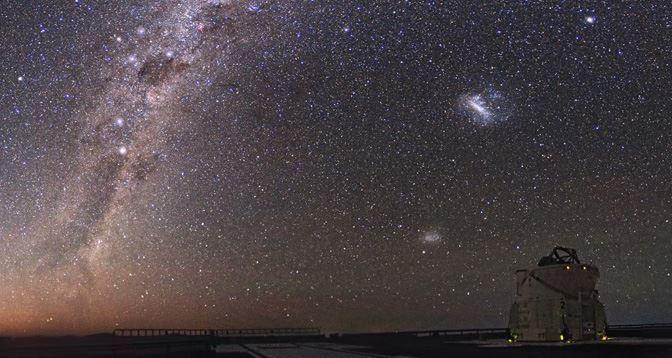Researchers uncover strikingly similar ways in which Indigenous peoples use the twinkling of stars to predict weather and seasonal changes.

The Milky Way and (at right) two Magellanic Clouds shine in the southern hemisphere above Cerro Paranal in Chile's Atacama Desert. Credit: ESO / Y. Beletsky.
Indigenous cultures on opposite sides of the world, with vastly different geographies and climates, interpret and use changes in starlight for marking seasons and weather forecasting in remarkably similar ways, according to researchers from Australia and Alaska.
Studies of Indigenous astronomical knowledge describe the pivotal role the properties of stars, such as colour, brightness and positions relative to the horizon, play in the lives of Indigenous communities, but little has been written about the role of stellar scintillation (twinkling).
Atmospheric turbulence, caused by changes in wind speed and direction, alter the refractive index of light, producing rapid changes in the brightness of the star, making it appear to twinkle: the greater the turbulence, the more pronounced the twinkling. Changes in air density, humidity and temperature also cause stars to change colour or appear hazy. Water in the atmosphere absorbs the green and red components of light more than blue - the predominance of blue over red and orange stars signifies increased moisture levels.
“I came across a reference to Melanesians using scintillation for predicting wind movements, but it was just a passing comment,” explains Dr Duane Hamacher, a Senior Research Fellow from the Monash Indigenous Centre at Monash University in Melbourne, Australia. “So I interviewed elders from the Meriam Mer community in the eastern Torres Strait where they described how they ‘read’ scintillations.”
Buoyed by this new information, Hamacher investigated further, and a fortuitous conversation at an Oceanic Cultural Astronomy conference in Hawaii with Chris Cannon, who studies the astronomical knowledge of the Northern Dene of Canada and Alaska, led to their collaboration.
“I first became interested in the Northern Dene while teaching astronomy to students in rural Alaska,” says Cannon, a PhD candidate at the Department of Anthropology at the University of Alaska in Fairbanks, United States. “A literature review showed not only a lack of published
information on the astronomy of the Northern Dene, but a misconception that their knowledge of the night sky was poorly developed.”
Together, they discovered both cultural groups have a similar understanding of how scintillation correlates with atmospheric conditions. A surprising result, given that the Torres Strait Islanders are sea-farers from the tropics with distinct wet and dry seasons, while the Northern Dene are from the interior of the arctic and sub-arctic, where half the year is dark and the other half is light.
To the Torres Strait Islanders, “reading” the stars informs them about winds, coming storms, hot weather, and the arrival of the strong northwest trade winds, heralding the wet season, called Kuki in the Merriam Mer language, from January to April.
“There are signs that the seasons change. We see it in trees and gardens, but mainly in the stars,” says Alo Tapim. Tapim is a Meriam elder from Murray Island and a participant in Hamacher’s research. “When the stars twinkle, it means the winds are picking up and fishermen capitalize on that, meaning they will have a good day at sea.”
For the Northern Dene this knowledge also facilitates weather forecasting, with the Ahtna and the Yellowknives Dene using brightly twinkling stars to forecast strong winds - vital information when hunting with sled dogs and skidoo.
The paper provides one of the few detailed ethnographic studies of Indigenous astronomy and - as global language diversity declines - is crucial to safeguarding Indigenous knowledge before it is lost forever.
“There are around 300 Aboriginal language groups in Australia and thousands of Indigenous communities world-wide, we want to expand our research to other Indigenous cultures to see how this knowledge is used in different locations and climates,” says Hamacher.
For further reading, please see Williams' October 2015 article in Australasian Science, "Aboriginal Astronomy & the Natural World." To view the article, you can subscribe to the magazine or purchase a yearly pass online.
By: Carl A. Williams

As a freelance science and technology writer, I combine my passion for science with a love of writing with storytelling that takes the reader on a journey of scientific exploration, discovery, and advancement. I write on a broad range of science topics, from climate change and astronomy to quantum computing and smart materials. And have published articles for Springer Nature, The Royal Institution of Australia, the Australian National Data Services, Australasian Science, Popular Science, and others. I previously worked as a climate change consultant, working with the public and private sectors in the UK, India, America, China, Europe, and Australasia. For a selection of my published writings, check out my website at https://gluons2galaxies.com.
